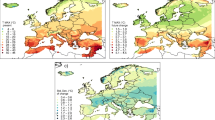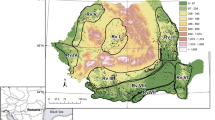Abstract
This research simulates the impact of climate change on the distribution of the most important European wine regions using a comprehensive suite of spatially informative layers, including bioclimatic indices and water deficit, as predictor variables. More specifically, a machine learning approach (Random Forest, RF) was first calibrated for the present period and applied to future climate conditions as simulated by HadCM3 General Circulation Model (GCM) to predict the possible spatial expansion and/or shift in potential grapevine cultivated area in 2020 and 2050 under A2 and B2 SRES scenarios. Projected changes in climate depicted by the GCM and SRES scenarios results in a progressive warming in all bioclimatic indices as well as increasing water deficit over the European domain, altering the climatic profile of each of the grapevine cultivated areas. The two main responses to these warmer and drier conditions are 1) progressive shifts of existing grapevine cultivated area to the north–northwest of their original ranges, and 2) expansion or contraction of the wine regions due to changes in within region suitability for grapevine cultivation. Wine regions with climatic conditions from the Mediterranean basin today (e.g., the Languedoc, Provence, Côtes Rhône Méridionales, etc.) were shown to potentially shift the most over time. Overall the results show the potential for a dramatic change in the landscape for winegrape production in Europe due to changes in climate.


Similar content being viewed by others
References
Allouche O, Tsoar A, Kadmon R (2006) Assessing the accuracy of species distribution models: prevalence, kappa and the true skill statistic (TSS). J Appl Ecol 43:1223–1232
Amerine MA, Winkler AJ (1944) Composition and quality of musts and wines of California grapes. Hilgardia 15:493–673
Bossard M, Feranec J, Otahel J (2000) Corine land cover technical guide — Addendum 2000. http://terrestrial.eionet.europa.eu/. EEA Technical report No 40. Copenhagen (EEA)
Breiman L (2001) Random forests. Mach Learn 45:5–32
Diffenbaugh NS, White MA, Jones GV, Ashfaq M (2011) Climate adaptation wedges: a case study of premium wine in the western United States. Environ Res Lett 6:024024. doi:10.1088/1748-9326/6/2/024024
Duchêne E, Schneider C (2005) Grapevine and climatic changes: a glance at the situation in Alsace. Agron Sustain Dev 25:93–99
Evans JS, Murphy MA, Holden ZA, Cushman SA (2011) Modeling species distribution and change using random forest. In: Drew CA et al (eds) Predictive species and habitat modeling in landscape ecology: concepts and applications. doi:10.1007/978-1-4419-7390-0_8, Springer Science+Business Media, LLC 2011
Fraederick K, Gerstengarbe FW, Werner PC (2001) Climate shift during the last century. Clim Chang 50:405–417
Fregoni M (2003) L’indice bioclimatico di qualitá Fregoni. In: Fregoni M et al (eds) Terroir, Zonazione Viticoltura. Phytoline, Piacenza, pp 115–127
Gaál M, Moriondo M, Bindi M (2012) Modelling the impact of climate change on the Hungarian wine regions using random forest. Appl Ecol Environ Res 10:121–140
Gladstones J (1992) Viticulture and environment. Winetitles, Adelaide
Godden P, Gishen M (2005) Trends in the composition of Australian wine. Aust N Z Wine Ind J 20:21–46
Hall A, Jones GV (2010) Spatial analysis of climate in winegrape-growing regions in Australia. Aust J Grape Wine Res 16:389–404
Hijmans RJ, Cameron SE, Parra JL, Jones PG, Jarvis A (2005) Very high resolution interpolated climate surfaces for global land areas. Int J Climatol 25:1965–1978
Huglin P (1978) Nouveau mode d’évaluation des possibilités héliothermiques d’un milieu viticole. C R Acad Agric France 1117–1126
Jones GV, Webb LB (2010) Climate change, viticulture, and wine: challenges and opportunities. J Wine Res 21:103–106
Jones GV, White MA, Cooper OR, Storchmann K (2005a) Climate change and global wine quality. Clim Chang 73:319–343. doi:10.1007/s10584-005-4704-2
Jones GV, Duchene E, Tomasi D, Yuste J, Braslavksa O, Schultz H, Martinez C, Boso S, Langellier F, Perruchot C, Guimberteau G (2005b) Changes in European winegrape phenology and relationships with climate. GESCO 2005
Jones GV, Duff AA, Hall A, Myers JW (2010) Spatial analysis of climate in winegrape growing regions in the western United States. Am J Enol Vitic 61:313–326
Keller M (2010) Managing grapevines to optimize fruit development in a challenging environment: a climate change primer for viticulturists. Aust J Grape Wine Res 16:56–69. doi:10.1111/j.1755-0238.2009.00077.x
Kenny GJ, Harrison PA (1992) The effects of climate variability and change on grape suitability in Europe. J Wine Res 3:163–183
Lavee S, May P (1997) Dormancy of grapevine buds—facts and speculation. Aust J Grape Wine Res 3:31–46
Malheiro AC, Santos JA, Fraga H, Pinto JG (2010) Climate change scenarios applied to viticultural zoning in Europe. Clim Res 43:163–177
Moriondo M, Bindi M, Fagarazzi C, Ferrise R, Trombi G (2011) Framework for high-resolution climate change impact assessment on grapevines at a regional scale. Reg Environ Change 11:553–567
Nakićenović N et al (2000) Special report on emissions scenarios: a special report of Working Group III of the Intergovernmental Panel on Climate Change. Cambridge University Press, Cambridge, 599 pp
Pope VD, Gallani ML, Rowntree PR, Stratton RA (2000) The impact of new physical parameterizations in the Hadley Centre climate model — HadAM3. Clim Dyn 16:123–146
Santos JA, Malheiro AC, Pinto JG, Jones GV (2012) Macroclimate and viticultural zoning in Europe: observed trends and atmospheric forcing. Clim Res 51:89–103
Shultz HR, Jones GV (2010) Climate induced historic and future changes in viticulture. J Wine Res 21:137–145
Stock M, Gerstengarbe FW, Kartshall T, Werner PC (2005) Reliability of climate change impact assessment for viticulture. Proc. VII IS on Grapevine (Ed. LE Williams). Acta Hort 689, ISHS pp 29–39
Tonietto J, Carbonneau A (2004) A multicriteria climatic classification system for grape-growing regions worldwide. Agric For Meteorol 124:81–97
Urhausen S, Brienen S, Kapala A, Simmer C (2011) Climatic conditions and their impact on viticulture in the Upper Moselle region. Clim Chang 109:349–373
White MA, Diffenbaugh NS, Jones GV, Pal JS, Giorgi F (2006) Extreme heat reduces and shifts United States premium wine production in the 21st century. Proc Natl Acad Sci U S A 103(30):11217–11222
Acknowledgments
This research was supported by the Commission of EU (Project MEDIATION, project no. 244012). The authors would like to gratefully acknowledge the constructive comments provided by the two anonymous referees.
Author information
Authors and Affiliations
Corresponding author
Electronic supplementary material
Below is the link to the electronic supplementary material.
ESM 1
Table describing climatic indices calculation (DOC 57.5 kb)
ESM 2
Table describing the spatial datasets used in this work (DOC 61 kb)
ESM 3
Description of the model of water balance (DOC 52 kb)
ESM 4
Description of Random Forest calibration strategy and relevant byproducts (Partial Plots) (DOC 3.59 MB)
ESM 5
Description of climatic structure of wine regions (DOC 323 kb)
ESM 6
Figures depicting the Random Forest accuracy in predicting grapevine cultivated area (Fig. 1, 2) and trend in wine regions shift in 2020 and 2050 (Fig. 3) (DOC 162 kb)
ESM 7
Tables showing Huglin index, Water deficit, minimum temperature of the coldest and maximum temperatures of warmest months of wine regions projected in 2020 and 2050 (A2 and B2 scenarios) (DOC 112 kb)
Rights and permissions
About this article
Cite this article
Moriondo, M., Jones, G.V., Bois, B. et al. Projected shifts of wine regions in response to climate change. Climatic Change 119, 825–839 (2013). https://doi.org/10.1007/s10584-013-0739-y
Received:
Accepted:
Published:
Issue Date:
DOI: https://doi.org/10.1007/s10584-013-0739-y




